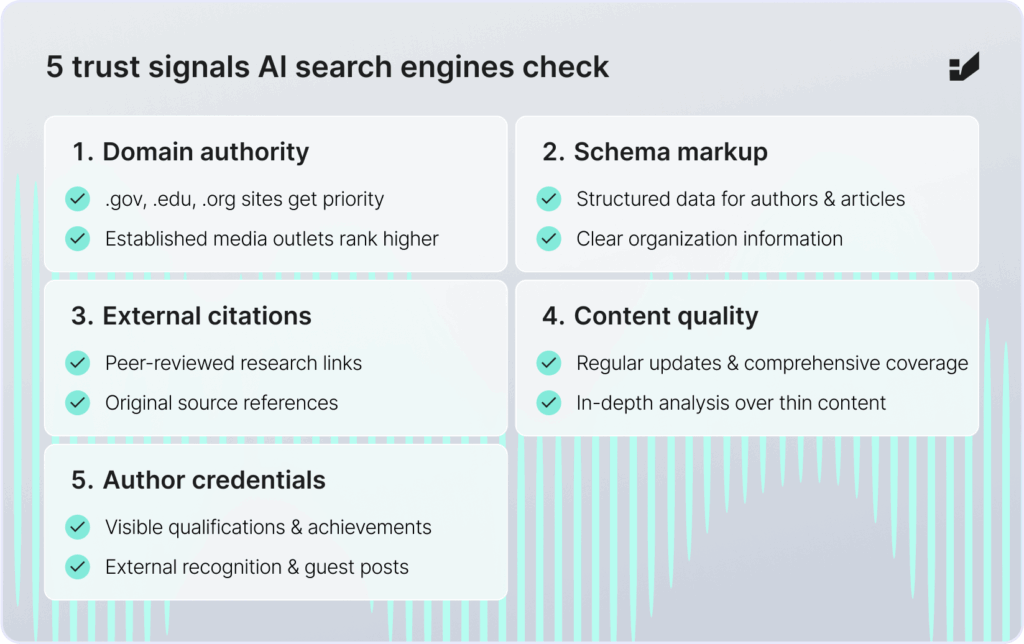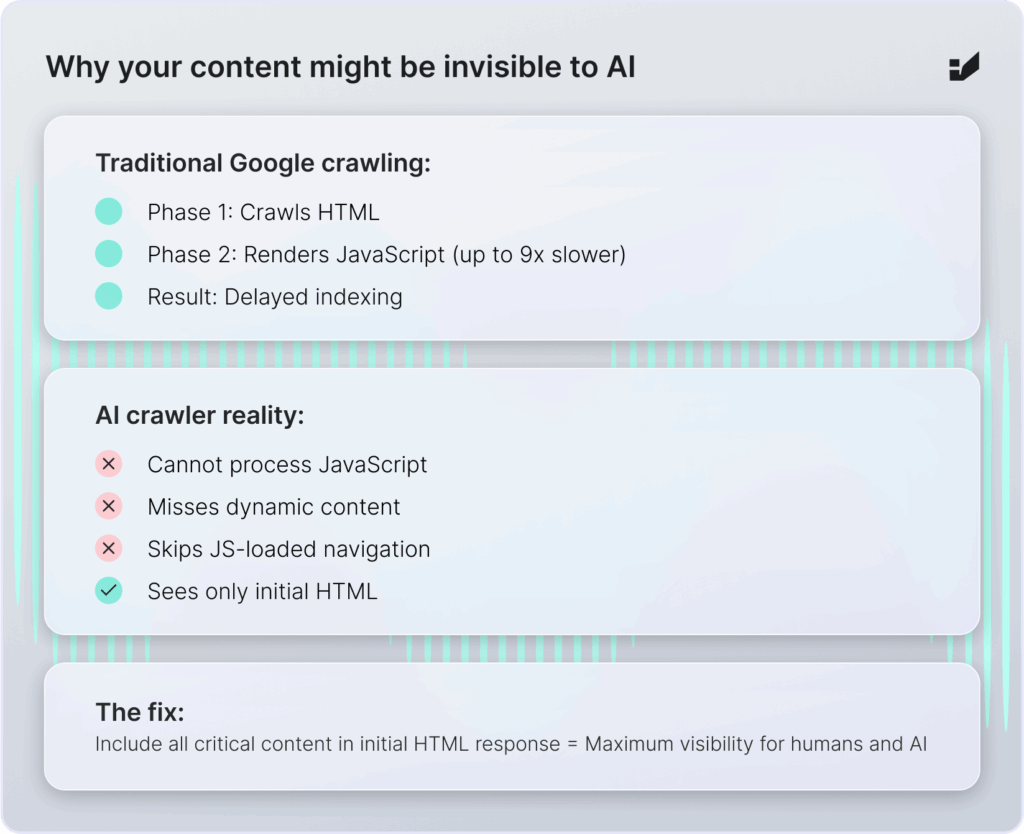E-E-A-T in the age of AI Search: Building trust with generative engines
Generative AI search engines, such as ChatGPT, Perplexity, Google's AI Overviews, and Claude, have transformed the way users find content online. Google's E-E-A-T framework – Experience, Expertise, Authoritativeness, and Trustworthiness – now determines whether content creators succeed with AI search engines.

The goal is straightforward: build genuine trust with both human users and the AI systems that now influence what people see online. Let’s examine how E-E-A-T principles work in the AI era and explore practical strategies for earning credibility with generative engines.
E-E-A-T’s role in AI search
E-E-A-T started in Google’s Search Quality Rater Guidelines as E-A-T back in 2014. Google added the extra “E” for Experience in December 2022 to recognize the value of first-hand knowledge. These criteria now extend beyond traditional SEO – they determine whether AI-generated answers will cite your content.
Experience shows you’ve done or used what you’re talking about. This first-hand knowledge adds authenticity that AI engines value more and more.
Expertise means you have specialized knowledge, relevant credentials, and a proven track record in your field.
Authoritativeness comes from external validation – industry recognition, quality backlinks, and a solid digital reputation.
Trustworthiness covers everything from content accuracy and transparency to having a secure, well-maintained website.

How generative AI engines evaluate trust
Generative AI tools work differently from traditional search. They pull information from multiple sources and use reasoning patterns to decide what content deserves citation. Here’s what they look for:
Domain and source signals
AI search engines trust certain domains more than others. Government (.gov), educational (.edu), and non-profit (.org) sites get priority, along with established media outlets. Having these sites link to you or being associated with them improves your chances of being cited.
Structured data and schema markup
Schema markup gives AI engines clear, structured information about your authors, articles, and organization. Since AI tools can’t interpret visual design cues like humans do, implementing proper schema for people, organizations, and articles helps them understand who you are and why you’re credible.
Citations and external validation
AI engines favor content that backs up claims with authoritative sources. Citing peer-reviewed research, original studies, and credible references tells the AI your information has solid foundations. This matters especially for health, finance, and other topics that affect people’s wellbeing.
Content freshness and depth
Generative engines want current, comprehensive information. Regular updates and thorough coverage signal ongoing expertise. Thin, outdated content rarely makes it into AI-generated responses.
Author and brand profiles
AI tools now actively check who wrote the content. They look for author bylines, credentials, and external recognition. A strong author profile with visible qualifications and achievements significantly boosts trust signals.

Strategies to build E-E-A-T for generative AI Search
Building AI trust requires going beyond basic SEO. Here are practical approaches:
1. Optimize for semantics and intent
AI search understands context, not just keywords. Structure content in topic clusters, use related terms naturally, and answer the real questions behind searches. Think about what your audience might ask a conversational AI and address those queries directly.
2. Strengthen the author authority
Don’t just list an author’s name. Create detailed bio pages, link to professional profiles, showcase credentials, and build external recognition through guest posts, podcast appearances, and industry citations. Use consistent author schema across your site.
3. Implement comprehensive schema markup
Add schema for organizations, authors, and articles throughout your website. Highlight certifications, memberships, and achievements through structured data. This helps AI engines connect content to credible entities. For more details on structured data and AI visibility, proper implementation makes a significant difference.
4. Create deep, high-quality content
Surface-level content won’t cut it. Provide thorough analysis, real case studies, expert insights, and practical resources. Reference authoritative sources and update important content regularly. The more comprehensive your coverage, the more likely you’ll beat competitors for AI citations.
5. Address technical trust and content rendering
Start with basics: HTTPS, fast loading, mobile optimization, and clear contact information. But there’s a critical factor many overlook – how your content renders for crawlers.
Many modern sites use JavaScript frameworks and single-page applications for a better user experience. While these create engaging sites, they pose serious challenges for search engines and AI crawlers.
Google crawls in two phases – first the raw HTML, then JavaScript-rendered content later. This can delay indexing significantly. Research shows JavaScript content can take up to nine times longer to index than plain HTML.

The situation is worse for AI crawlers. Most language model crawlers (used by ChatGPT, Claude, Perplexity, and others) don’t process JavaScript at all. They only see the initial HTML. If your main content, navigation, or contact details load via JavaScript, these bots miss everything.
The solution: Ensure all critical information appears in the initial HTML response. This maximizes visibility for both traditional search and AI systems.
6. Build social proof
Display genuine testimonials, case studies, and industry recognition. AI engines increasingly consider social signals when evaluating reputation. User reviews, awards, and third-party endorsements all strengthen your credibility profile.
Challenges: The trustworthiness problem
Generative AI has limitations. Stanford research found that up to 50% of AI-generated answers lack proper supporting citations, and 25% of cited links don’t actually support the AI’s claims. This creates a situation where smooth-sounding AI responses might not be the most accurate.
For content creators, this means focusing on being cited by authoritative sources and maintaining rigorously fact-checked, updated material.
Measuring success in AI Search
Traditional SEO metrics tell only part of the story. New Generative Engine Optimization (GEO) tools track how often and in what context AI systems mention your brand or cite your content. Monitor:
- Frequency of citations in AI responses
- Context and sentiment of mentions
- Authority level when cited
- Comparison to competitors
These metrics reveal whether your E-E-A-T efforts are working in AI discovery.
The path forward
AI-driven search is becoming more conversational, mixing text, voice, and visual inputs. To stay competitive:
- Update expert content regularly
- Diversify into multimedia formats where appropriate
- Prepare for voice and image search
- Match content to diverse user needs and contexts

Key takeaways
With generative AI reshaping how people find information, E-E-A-T has become crucial for both visibility and trust. Success requires demonstrating real expertise, providing unique value, and maintaining trustworthiness across all digital touchpoints.
Focus on showcasing genuine expertise, supporting claims with credible sources, structuring your site for AI comprehension, and consistently solving real problems for your audience. Organizations that commit to these principles won’t just rank well – they’ll build lasting authority in the digital space.



